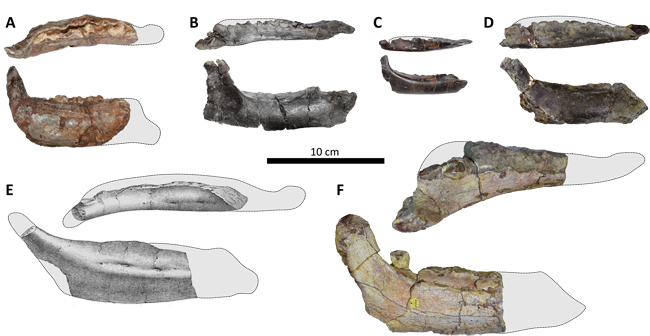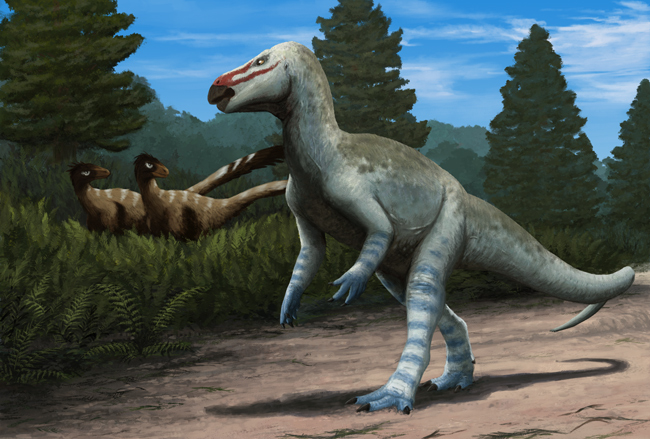Remarkable European Rhabdodontomorph Dentaries
Our thanks to Dr Lukasz Czepiński (Institute of Paleobiology, Polish Academy of Sciences) for helping Everything Dinosaur. We had written a blog post about the scientific description of a new taxon of European rhabdodontomorph. It had been published a few days ago. This dinosaur has been named Obelignathus septimanicus and we contacted one of the authors of the study to request an image showing the Obelignathus septimanicus fossils. A few days later, we received an email from Dr Czepiński enclosing an image showing the robust dentary of Obelignathus compared to the lower jaws of other rhabdodontomorphs.

Dentaries of selected European rhabdodontomorphs in dorsal and lateral views. The Obelignathus septimanicus fossils (A) are compared with (B) Mochlodon vorosi holotype (MTM V 2010.105.1), a left dentary from the Csehbánya Formation, Iharkút (Hungary; mirrored) with (C) Mochlodon suessi, lectotype (PIUW 2349/2), right dentary from the Grünbach Formation, Muthmannsdorf (Austria). Furthermore, (D) Zalmoxes robustus holotype (NHMUK R3392), right dentary from the Sinpetru Formation, Sânpetru (Romania); along with (E) Rhabdodon priscus, lectotype (MPLM 30), left dentary from the Marnes Rouges Inférieures Formation, la Nerthe (France) and (F) Zalmoxes shqiperorum holotype NHMUK R4900, right dentary from the Sinpetru Formation of Sânpetru (Romania; outline based on the specimen UBB NVZ1-1). Note the scale bar equals 10 cm. Picture credit: Czepiński and Madzia.
Picture credit: Czepiński and Madzia
Obelignathus septimanicus Fossils
Examination of a robust dentary (specimen number MDE D30) led to the establishment of this new taxon. The stout jaw inspired the researchers when it came to naming this new dinosaur. The genus name honours the immensely strong Obélix from the Asterix the Gaul series and the Latin word for jaw.
The jaw fossil had been discovered in 1990. In 1991, French palaeontologists Jean Le Loueff and Eric Buffetaut assigned it to the genus Rhabdodon but erected a new species R. septimanicus. The species name honours Septimania the historical name of this part of France from Roman times.
To read Everything Dinosaur’s original blog post about the scientific description of O. septimanicus: “Obélix Jaw” – A New Late Cretaceous Ornithopod Dinosaur.

Life restoration of newly described rhabdodontid dinosaur Obelignathus septimanicus in the Late Cretaceous environment recorded in the ‘Grès à Reptiles’ Formation in southern France. A pair of dromaeosaurid dinosaurs can be seen lurking in the background. Picture credit: Edyta Felcyn-Kowalska.
Picture credit: Edyta Felcyn-Kowalska
We also received an image showing a life reconstruction of Obelignathus septimanicus (see above).
Everything Dinosaur acknowledges the assistance of one of the authors (Łukasz Czepiński), in the posting up of these images. Thank you Dr Czepiński for your assistance. We wish you every success with your research.
The scientific paper: “Exploring the diversity and disparity of rhabdodontomorph ornithopods from the Late Cretaceous European archipelago” by Łukasz Czepiński and Daniel Madzia published in Scientific Reports.
Visit: Everything Dinosaur for dinosaur toys and prehistoric animal figures.

